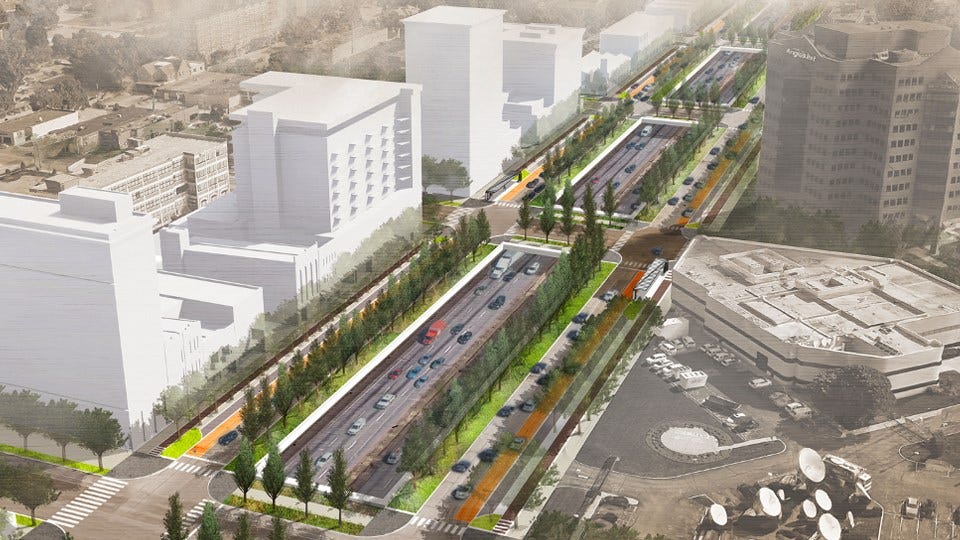Rethink Coalition Pushes for Recessed Highway System
 Artist rendering of a recessed Indy highway. (image courtesy Rethink Coalition Inc & Indy Chamber)
Artist rendering of a recessed Indy highway. (image courtesy Rethink Coalition Inc & Indy Chamber)
Subscriber Benefit
As a subscriber you can listen to articles at work, in the car, or while you work out. Subscribe NowThe Indy Chamber and Rethink Coalition Inc. have released findings of a study that looks at two options for rebuilding I-65 and I-70 through downtown Indianapolis. The Inner Loop Visionary Study also provides a preliminary analysis of the cost and benefits of the massive infrastructure project. The study looked at two possible options – rebuilding the highways as is at a cost of $2.3 billion or creating a recessed system at a projected cost of $2.8 billion, the latter of which is favored by the organization.
“This is not a once in a generation opportunity. This is once in two generations,” said Charlie Richardson, Rethink Coalition co-chair and retired partner at Faegre Drinker. “This is 50 years and beyond. We all have to participate in this community conversation because this is our moment.”
The final segment of the downtown Indianapolis interstate system was completed 45 years ago. The organization says the inner loop is approaching the end of its functional life. The group commissioned Arup Inc., a Canadian-based engineering and transportation planning firm, to analyze the project.
With the $280 million North Split interchange project currently underway, the organization says its project takes a broader, long-term look at the three legs that makeup the inner loop – I-65 on the north edge, I-65 and I-70 to the east, and I-70 on the south.
“We’re at a critical juncture for the post-COVID future of downtown Indianapolis, and infrastructure has to be part of our blueprint for continued growth and vitality for Indiana’s capital city and biggest urban economy,” said Indy Chamber President and Chief Executive Officer Michael Huber. “We need to balance total costs, transportation, and safety demands, but also prioritize inclusive economic development, connectivity, and quality of life before locking ourselves into the status quo.”
The recessed option would remove elevated sections of interstate and rebuild them below grade while maintaining current capacity. The Arup analysis finds this option could reclaim 45 acres of land within the current interstate right-of-way and create up to 23 acres of additional new land by “capping” over the recessed system.
While the in-ground system is more expensive, the organizations say the difference could be paid for putting land back into the market.
“The Arup study shows that the 20% higher upfront cost will easily pay for itself through value-capture financing, even before considering the critical inclusive economic benefits to our region,” said Russell Menyhart, partner at Taft Stettinius & Hollister LLP and co-chair of the Rethink Coalition. “Infrastructure shouldn’t be treated as a cost, but an investment.”
Rethink Coalition CEO Brenda Freije says Indianapolis and central Indiana must expand the criteria typically used for highway planning.
“We need to count new jobs, investment and tax revenue, and reductions in noise and pollution alongside traffic volume,” said Freije. “The highways, as we know, impacts so much more than just transportation in vehicles and trucks. It has an impact on our health. It has an impact on the way our communities are structured, it has an impact on the way people visit the city, and the way they find entertainment and play in the city.”
Taylor Hughes, the director of strategy, policy and special projects for Indy Chamber says the current infrastructure bill before Congress includes funding to cover a broader study on proposed projects like this.
“Tis is not a fully engineered plan. Future studies to get more specific will need to occur. There’s currently funding that does exist for exactly those types of studies and on projects that look exactly like the inner loop study,” said Hughes.
The organization is sharing its analysis with the Indiana Department of Transportation. The proposed project is not part of INDOT’s five-year plan. However, the coalition wants it to be part of the conversation and planning for decades ahead.
“The timeline for these plans may be measured in years or even decades, but the time to start the discussion is now,” said Richardson.
The group says it will conduct public meetings to seek community input on the project. Click here to view the analysis.
Rethink Coalition CEO Brenda Freije said the infrastructure project isn’t just about building better roadways.
